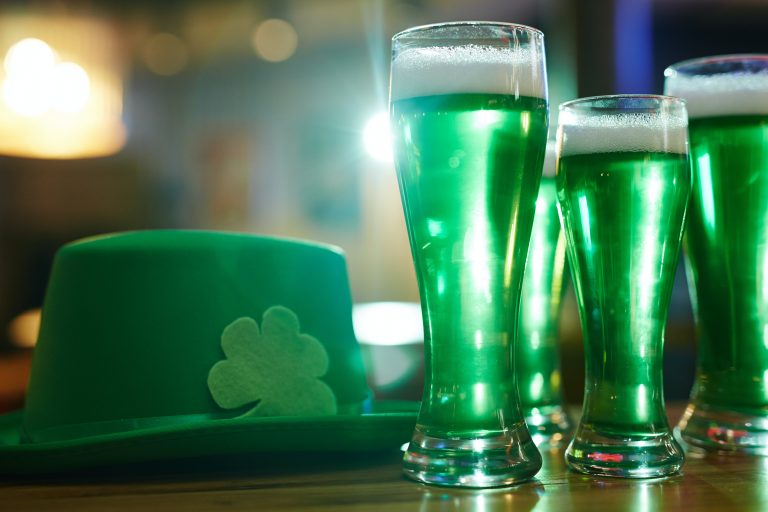The National Retail Federation (NRF) conducts an annual survey in advance of St. Patrick’s Day asking Americans how they plan to celebrate the holiday, and compiles the data into a handy dashboard depicting year-over-year trends.
Last year, summarizing its findings on February 27, the organization noted that 56% of respondents planned to celebrate the holiday — a surprisingly high mark, despite it falling on a weekday — and proclaimed that “consumers are feeling lucky this St. Patrick’s Day.”
As it turned out, the COVID-19 pandemic hit the United States in full force in the following weeks. The rapid news cycles of those second and third weeks of March meant that while countless parades scheduled for the 17th were canceled, the severity of the pandemic may not have totally set in by the prior couple weekends, when COVID-19 precautions were barely formalized and sizable crowds gathered to celebrate anyway in cities like Chicago and Hoboken, New Jersey.
In the last year, the pandemic has transformed holiday rituals. Unsurprisingly, fixtures of traditional St. Patrick’s Day celebrations will be limited this year: parades are a no-go once again, and many of the bars that are open are operating at reduced capacity. Yet the NRF survey this year reveals that 49% of consumers still plan to celebrate in some way, which is the lowest percentage since 2010, but not nearly as precipitous of a drop-off from last year’s mark as one might expect. And these consumers still plan to spend an average of $40.77, which is actually the second-highest recorded mark ever, behind 2020. So what gives?
First of all, it should be noted that the NRF uses a very lenient definition of what constitutes “celebrating” St. Patrick’s Day. In the NRF’s survey, simply wearing green is enough to be considered a participant in the holiday, even though its economic impact is minimal outside of some consumers potentially buying new green apparel. The same percentage of those celebrating, 79%, plan to wear green in 2021 as did in 2020.
Business journalists planning to write about the economic impact of St. Patrick’s Day should focus instead on the other methods of celebration, which have altered in relative importance dramatically over the course of the pandemic. In 2020, 28% of consumers planned to “make a special dinner,” while 27% planned to celebrate at a bar or restaurant. Now, 42% will be dining in and 10% will be going out.
Therefore, the influence of grocery stores on St. Patrick’s Day celebrations has increased dramatically. How are they responding? Are they stocking up on traditional Irish food, as Costco is with soda bread, or specialty green items, as Aldi has in the past with pesto- and sage-infused cheeses? What kinds of alcohol are they buying, knowing customers are more likely to dine at home?
Meanwhile, how are bars and restaurants responding to the loss of their traditional control over the holiday? In some cities, they may be benefiting from recently loosened COVID-19 restrictions, but how can they convince customers to come back? Will they do it with specialty menu items of their own, like corned beef and cabbage?
Local Irish associations also play a considerable role in St. Patrick’s Day festivities and should be considered a useful resource for business reporting. What can they do to help their members observe the holiday in an unprecedented climate? Perhaps they might hold a home decorating contest, as in Chicago. (The percentage of celebrants who plan to decorate homes or offices nationwide is up this year from 24% to 32%.) Or they could opt for a purely virtual program, as Milwaukee’s CelticMKE did, with their eight-hour cultural extravaganza.
Localized business stories should also take into account regional differences when covering these topics. The NRF provides valuable statistics for guidance here: 48% of consumers in the Northeast plan to “make a special dinner,” compared to 38% in the South. Conversely, 83% of Southerners plan to wear green, compared to 71% of Northeasterners. And while St. Patrick’s Day parades are typically most popular in the Northeast, the pandemic has leveled the proportion of consumers who plan to participate in parades across various regions of the country.
Last year’s St. Patrick’s Day occurred in a surreal, liminal period when much of the population did not yet know the severity of the pandemic. Now this year’s holiday occurs amid a different sort of drawn-out transitional time, as more and more of the population gets vaccinated and some businesses fully reopen, but COVID-19 continues to infect tens of thousands nationwide each day. The only way to truly know how different regions of the country plan to observe the holiday amid such strange circumstances is to get out there and report, looking to grocery stores, bars and Irish cultural associations for inspiration.











